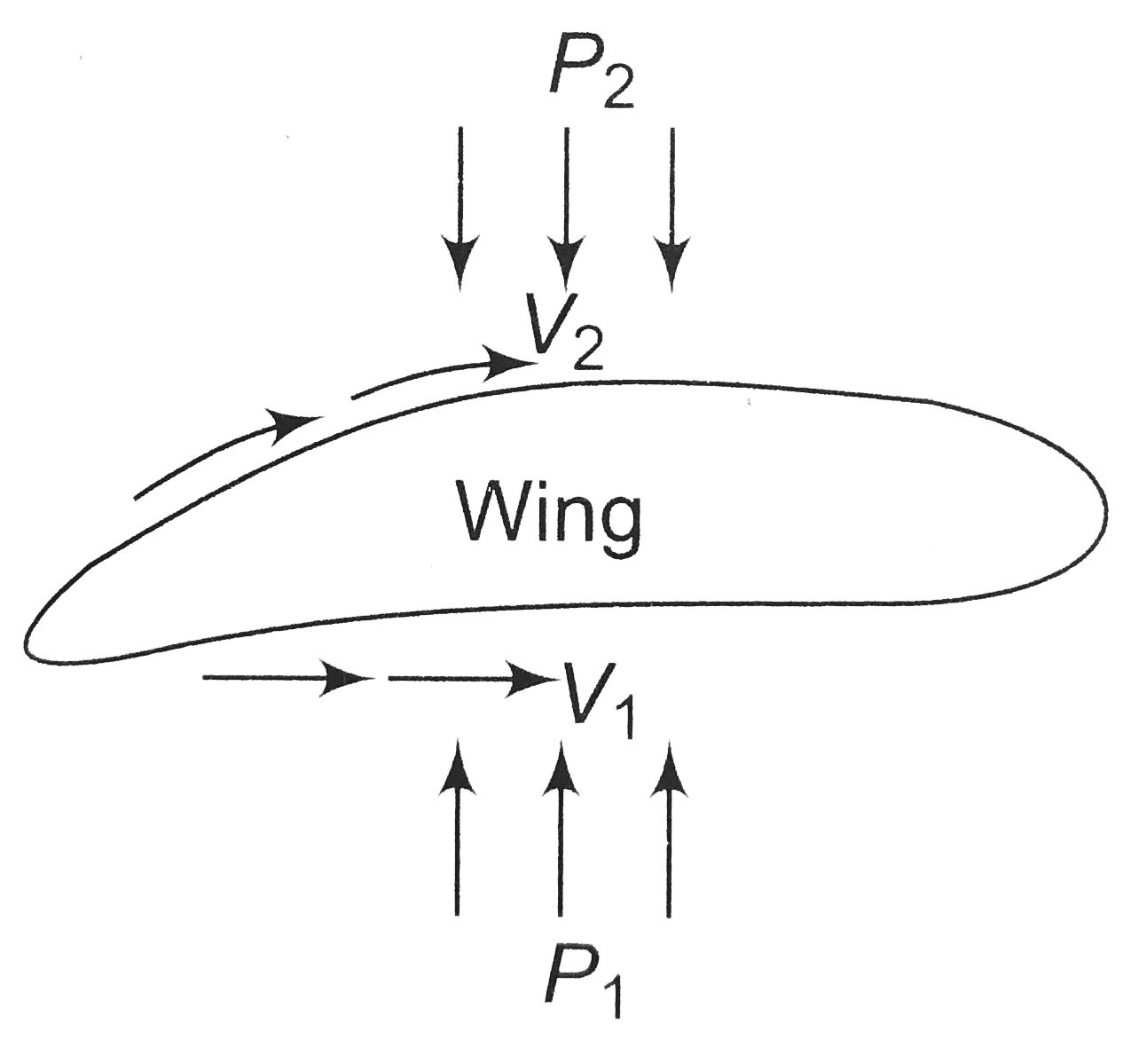Air flows horizontally with a speed v = 108 km/hr . A house has a plane roof of area A = 20 m2 . Find the magnitude of aerodynamic lift on the roof . [ Density of air =1.3kg/m3]
To find the magnitude of aerodynamic lift on the roof of the house, we can follow these steps:
Step 1: Convert the speed from km/hr to m/s
The speed of air is given as v=108km/hr. To convert this to meters per second, we use the conversion factor 518.
v=108km/hr×518=30m/s
Step 2: Use Bernoulli's equation to find the pressure difference
According to Bernoulli's principle, the pressure difference between two points can be expressed as:
P2−P1=12ρv21
Where:
- P1 is the pressure above the roof (where the air is flowing),
- P2 is the pressure below the roof,
- ρ is the density of air (given as 1.3kg/m3),
- v1 is the speed of air above the roof (which we found to be 30m/s).
Step 3: Calculate the pressure difference
Substituting the values into the equation:
P2−P1=12×1.3kg/m3×(30m/s)2
Calculating (30m/s)2:
(30)2=900m2/s2
Now substituting this back:
P2−P1=12×1.3×900=0.65×900=585Pa
Step 4: Calculate the lift force
The lift force FL can be calculated using the pressure difference and the area of the roof:
FL=(P2−P1)×A
Where A=20m2:
FL=585Pa×20m2=11700N
Final Answer
The magnitude of the aerodynamic lift on the roof is:
FL=11700N
The speed of air is given as v=108km/hr. To convert this to meters per second, we use the conversion factor 518.
According to Bernoulli's principle, the pressure difference between two points can be expressed as:
- P1 is the pressure above the roof (where the air is flowing),
- P2 is the pressure below the roof,
- ρ is the density of air (given as 1.3kg/m3),
- v1 is the speed of air above the roof (which we found to be 30m/s).
Substituting the values into the equation:
The lift force FL can be calculated using the pressure difference and the area of the roof:
The magnitude of the aerodynamic lift on the roof is:
Topper's Solved these Questions
- BOOK - FIITJEECHAPTER - FLUID MECHANICS EXERCISE - ASSIGHNMENT PROBLEMS (OBJECTIVE ) LEVEL I40videos
FLUID MECHANICS
- BOOK - FIITJEECHAPTER - FLUID MECHANICS EXERCISE - ASSIGHNMENT PROBLEMS (OBJECTIVE ) ASSERTION REASONING TYPE LEVEL -I1videos
FLUID MECHANICS
- BOOK - FIITJEECHAPTER - FLUID MECHANICS EXERCISE - ASSIGHNMENT PROBLEMS (SUBJECTIVE ) TRUE OR FALSE QUESTIONS (LEVEL-I)6videos
FLUID MECHANICS
- BOOK - FIITJEECHAPTER - ELECTROSTATICSEXERCISE - Example14videos
ELECTROSTATICS
- BOOK - FIITJEECHAPTER - GENERAL PHYSICSEXERCISE - MATRIX MATCH TYPE3videos
GENERAL PHYSICS
Similar Questions
Knowledge Check
- Question 1 - Select One
Air flows horizontally with a speed v= 106 km/hr. A house has plane roof of area A=20m2 The magnitude of aerodynamic lift of the roof is
A1.127×104NB5.0×104NC1.127×105ND3.127×104N - Question 2 - Select One
What is the height of air column which will produce a pressure of 1 atm? Density of air is 1.3 kg/m3.
A6.45 kmB7.20 kmC7.95 kmD8.40 km - Question 3 - Select One
The speed of flow past the lower surface of a wing of an aeroplane is 50ms−1. What speed of flow over the upper surface will give a dynamic lift of 1000Pa? Density of air =1.3kgm−3
 A25.55m/sB63.55m/sC13.25m/sDNone of these
A25.55m/sB63.55m/sC13.25m/sDNone of these
A house has a volume of 600m3.
What is the total mass of air inside the house at 0∘C?View SolutionAn iron ball has an air space in it. It weighs 1 kg in air and 0.6 kg in water .Find the volume of air space. Density of iron =7200kgm3.
View SolutionA water droplet 4.0 mm in diameter is falling with a speed of 10 km/h at an altitude of 20 km. Another droplet 6.0 mm in diameter is falling at 25% of that speed and at 25% of that altitude. The density of air at 20 km is 0.20kg/m3and that at 5.0 km is 0.70kg/m3 Assume that the drag coefficient C is the same for the two drops. Find the ratio of the drag force on the higher drop to that on the lower drop.
View SolutionFigure shows a crude type of atomizer. is compressed, air flows swiftly through tube BC causing a reduced pressure in the particles of the vertical to Liquid rises in the tube, enters BC and is sprayed out. if the pressure in the bulb is Pa+P, where P is the gauge pressure and Pa is the atmospheric pressure, v is the speed of air in BC, find how large would v need to be to cause the liquid to rise to BC. Density of air =1.3kg/m3.
 View Solution
View SolutionAir stream flows horizontally past an aeroplane wing of surface area 4m2. The speed of air over the top surface is 60ms−1 and under the bottom surface is 40ms−1 The force of lift on the wing is (density of air =1kgm−3)
View Solution

